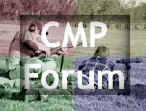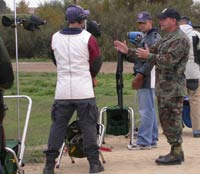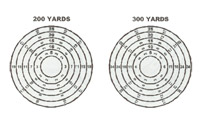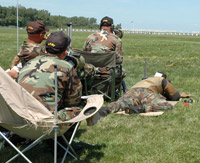

| We want your feedback! Please let us know what you think about TFS. Do you have an interesting story or article that you would like to share? If so, please let us know!
|
Reader Comments:
The article about Bill Krilling was very good, a great shooter, coach and a gentlemen to boot!
Ruth S.
Thanksfor the great stories and tips. Even old dogs can learn new tricks. This is great for keeping the CMP active.
Tim H., AZ
I just read the article on slings. Very good! Please include other "how to" items in the future.
David S.
Moxee, WA
The story of the M1 rifle that was presented to Shifty of the 101 airborne makes me proud to be part of the shooting community. Thank you for adding it to the TFS.
Mike S.
What a great article: “A Rifle for Shifty” … that has to be one of the best stories I’ve read in quite some time. Thanks for publishing it.
Alex N.
Thank You again Christine, very good articles.
JM
Ms. Elder, just a note to say that there are few things I look forward to receiving by email, and the Shooting News publication is one of them!
It is always a high quality publication with a nice mix of text and image, about interesting things and folks.
Keep up the good work!
Phil B., Ph.D.
Annapolis, MD
That was a great story! Thanks for publishing it.
Regards from Dakota,
Jim S.
PS: I forwarded it to all my shooter friends.
This story about the "Gift for Shifty" is one of the best stories I have read so far....An example of selfless appreciation for the WW2 vets that helped make this such a wonderful country...God bless our past and present troops.
Ron W.
The story "A Rifle For Shifty" really hit me. What a wonderful tribute to one of this countries nearly forgotten heroes.
Kudos to all who were involved with finding and presenting him with "his" rifle. Thanks to those of you who shared the story.
Regards,
John S.
I thoroughly enjoyed reading A Rifle for Shifty. We owe our WW2 veterans a debt we can never repay. I wish I could provide all of them with a similar token of appreciation.
Jeff C.
Love the newsletter. Looks good and to the point. In the Navy we have a signal that signifies an excellent job. Bravo Zulu to the staff.
Keep up the good work from an old retired Command Master Chief USN
I enjoy reading The First Shot... keep up the good work.
Ron
Just a note to tell you that I really appreciate the CMP Shooter's News. Thanks for all your efforts in putting it out to everyone.
Best regards,
Dan S.
|
|
|
 |

Reading the Wind (Part 1, Rapid Fire)
By SSG Emil Praslick, USAMU
|
 |
|
SSG Emil Praslick (r.) instructs another shooter in a service rifle clinic during the 2005 Western CMP Games and Creedmoor Cup Matches.
|
The term, “Reading the Wind” is misleading. A more apt title might be “The tactical negotiation of varying wind conditions and the limitation of their negative effects on the flight of your bullet.” In this article we will discuss some tactics and techniques that will enhance your abilities to negotiate the wind and (hopefully) add a few points to your score. This article will be divided into two sections: part one will cover the 200 and 300 yard stages. The second part (forthcoming) will be devoted to the 600 yard stage.
There are as many dimensions to “wind reading” as there are stages to High Power competition. Your tactical mindset, or philosophy, must be different for the 200 and 300 yard rapid-fire stages than it would be for the 600 yard slow-fire. In the slow-fire stages you have the ability to adjust windage from shot to shot, utilizing the location of the previous shot as an indicator. Additionally, a change to the existing conditions can be identified and adjusted for prior to shooting the next shot.
During a rapid fire string you will be afforded, in optimum conditions, two chances to make a correction prior to or during firing: one before commencing the string, and one during the magazine change. This requires a different approach to analyzing the wind condition than slow fire shooting. In the following section I will cover some of the basics, and attempt to describe the approach I use, both as a coach and shooter, to centering a rapid fire group.
|

|
-
Once you have moved your equipment to the ready line, begin to observe the conditions. Do not wait until the command, “All ready on the firing line!” to make a decision about the wind.
-
Assess the direction, value, and the speed of the wind. There are a myriad of wind charts and formulas available to determine the amount of windage required to offset the wind’s effect on the flight of your bullet. Your best estimate should be checked against that of your fellow competitors. One of your best tools is the knowledge (and the results on the target) of your peers.
-
An often neglected and misunderstood tool is the use of range/wind flags. Immediately prior to assuming the sitting or prone position (while standing) you will not be able to use your spotting scope to check the mirage; you will, however, be able to see the wind flags. It is important to correlate what you can see in the mirage with the behavior of the flags. Alternate between looking at the mirage of a known condition, and observing the flags. Concentrate on the details. Pay close attention to the very end, or tip of the flag. A subtle increase in the speed of the wind will not change the height and angle of the flag, but it will affect action at the tip.
-
Once you have identified a condition, both in the mirage and flags, observe its duration. Because you must fire the majority of your string without making a wind change, you must know what might result from any variance to the predominant condition. This is what we call determining a bracket.
-
Sighters, when available, should be used to determine the bracket of the wind condition. One technique is to stagger the interval of your sighting shots: fire your first shot as you would normally, and then wait until the conditions change-or just prior to the expiration of time to fire your second sighter. This will aid you in identifying the condition closest to your actual string of fire.
-
If there is the likelihood of a change to the condition, the windage you place on the rifle might need to be a compromise between a perfectly centered group and the damage a change might cause. One technique that experienced shooters employ in a changing condition is to identify the “safe side” of the 10-ring. For example, if the observed condition is one minute of wind from the right, gusting to two minutes, a savvy competitor might center his group on the right side of the X/10 ring. In the event of a pick up, the wind gust would simply move the group to the center of the target or to the other side of the 10-ring. Obviously, the effectiveness of this technique is determined by your ability to shoot a small group. This should be an incentive to train!
-
The width of the 10-ring in highpower rifle is two minutes of angle. Theoretically, a wind estimate within one minute of the correct value should result in a “clean.” In practice, the quality of the estimate must be much higher. An individual’s ability to maintain sight alignment, sight picture, and a steady position (along with the accuracy of the rifle) will determine the amount of error available to you in your wind estimate. Once again, this fact alone should be a powerful incentive to train!
-
The risk of making a windage correction during the magazine change often outweighs the benefits, especially with beginning shooters. A good performance and the ability to shoot a tight group is the origin of the shooter axiom: “A good hold is worth a minute.” As a rule, unless you can clearly see your group outside the 10-ring in your spotting scope, do not adjust your sights during the magazine change. There have been many disasters wrought from a shooter mistaking a paster; tear in the paper, or insect for a bullet hole.
|

|
Finally, although wind reading is an important shooter skill, your ability to master the fundamentals is the most important factor in shooting high scores. By trusting in your ability, talking to your fellow shooters, and concentrating on your performance, your scores will improve. In the next installment, we will discuss the different techniques required to read the wind during the slow fire stages of the National Match Course.
|
|
|


